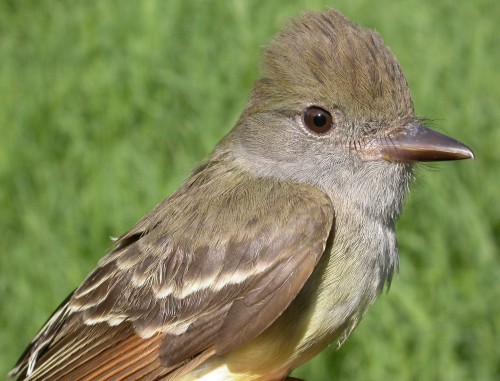|
McGILL BIRD OBSERVATORY |
|||||||||||||||||||||||||||||||||||||||||||||||||||||||||||||||||||||||||||||||||||||||||||
Welcome
to the McGill Bird Observatory weekly report.
Click here for a complete listing of our archives.
Banders-in-charge:
Marcel Gahbauer, Marie-Anne Hudson, Barbara Frei Notes: Well, the spring season ended with more of a whimper than a bang, but that's not entirely a bad thing - after all, if migration were still going strong at this point, we would be shutting down too soon. Nonetheless, it was a rather dull week, with migration dropping off very dramatically at the end of last week. Whereas last week we observed at least 55 species every day, this week we weren't able to reach that number even once! The total number of species observed during the week also underwent a sharp decline, from 99 last week to just 74 this week, and did not include even a single new species for the season. All the same, the final week was worthwhile as it allowed us to document the late season migrants well. Blackpoll Warbler, Yellow-bellied Flycatcher, and Black-billed Cuckoo were among the species still on the move this week. Meanwhile, the breeding season is well underway for many earlier arrivals, with young Wood Ducks already being spotted on the pond, and various other species observed nesting, including Mourning Dove, American Robin, Yellow Warbler, and Song Sparrow.
With only 29 birds banded this week, the top 10 list is rather thin. Still, it is of note that the omnipresent Red-winged Blackbird finally got nudged out of top spot, by Cedar Waxwing. Also interesting is that we banded our first two Black-capped Chickadees in nearly a month this week. Their migration has been impressive this spring just a bit further west (e.g. Rochester, New York and Ottawa, Ontario), but we seemed to see those flocks only in fall as they moved south. The ten species most frequently observed this week were the same as last week, though their order of abundance changed considerably. In particular, large flocks of Ring-billed Gulls and American Crows were a much more frequent sight in week 9. Several species moved up in the rankings this week, such as Yellow Warbler, Cedar Waxwing, American Goldfinch, Tree Swallow, and Song Sparrow, but in all cases the mean number observed was actually lower than last week. This reflects the overall decline in birds recorded this week, a pattern which is probably explained both by the departure of late migrants, and by more local birds settling down to nest and consequently being less vocal and active. We would like to take this opportunity to thank all the volunteers who helped us throughout the 10-week spring season, as well as everyone who has helped support MBO financially - we couldn't do it without your help! Below is a sneak preview of the season totals; we are preparing a full report and hope to publish it within the next few weeks. Activities at MBO will be scaled back considerably in summer, but daily coverage will resume in less than two months when the fall season begins on August 1!
While the number of Red-winged Blackbirds this spring more than doubled the 2005 spring total (74 to 168), this increase was offset by the dramatic drop in numbers of last year's other top three species, American Goldfinch (111 to 32) and Cedar Waxwing (59 to 15). Others that increased notably compared to 2005 were Ruby-crowned Kinglet (20 to 55) and Slate-coloured Junco (5 to 47). This year the bottom of the top ten was rounded out by four warbler species. The Yellow-rumped Warbler and Common Yellowthroat swapped totals and rankings between years, while Magnolia Warblers were much more numerous this spring (22 banded) than last (5). Far fewer Yellow Warblers were banded this spring, but it is worth noting that an additional 11 returns were caught, bringing the total a bit closer to what it was last year. Similarly, fewer Song Sparrows were banded this spring (20) than last (30), but once the 19 returns are factored in, we actually captured more individuals this spring. Of the 148 species observed during the spring season, 17 of them were observed on just one day (Black-crowned Night Heron, Brant, Green-winged Teal, Northern Shoveler, American Wigeon, Hooded Merganser, Common Merganser, White-winged Scoter, Broad-winged Hawk, Rough-legged Hawk, American Kestrel, Semipalmated Plover, Spotted Sandpiper, Willow Flycatcher, Purple Martin, Bay-breasted Warbler, and Palm Warbler). At the opposite end of the spectrum, 6 species (Ring-billed Gull, American Crow, American Robin, Northern Cardinal, Red-winged Blackbird, and House Sparrow) were seen each of the 69 days that we were present, and another 8 species (Canada Goose, Wood Duck, Mallard, Eastern Phoebe, Blue Jay, Black-capped Chickadee, Song Sparrow, and American Goldfinch) were recorded on at least 65 of 69 days. More detailed summaries and analyses of the spring data will be presented in the full seasonal report. Watch for our monthly summer updates at the end of June and July; weekly updates will resume in August.
|


